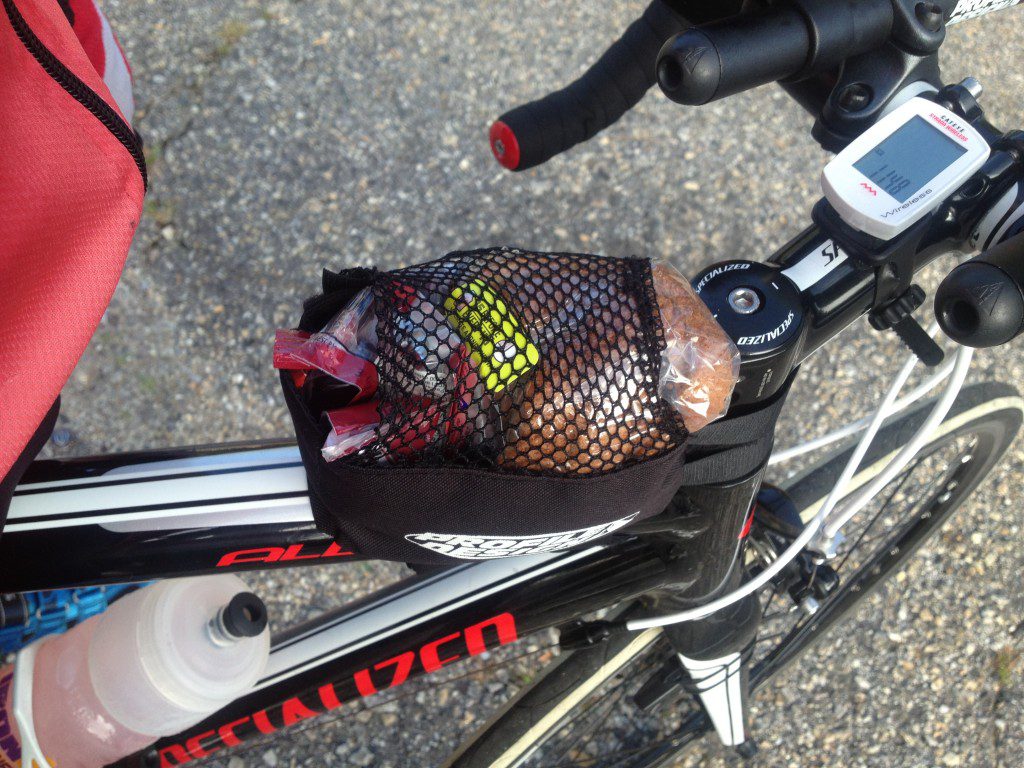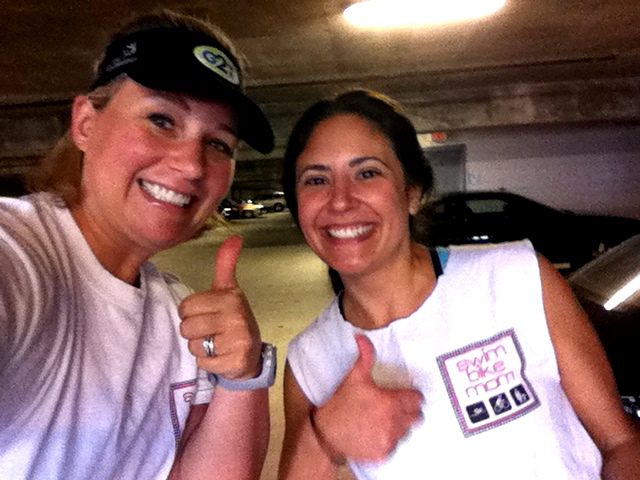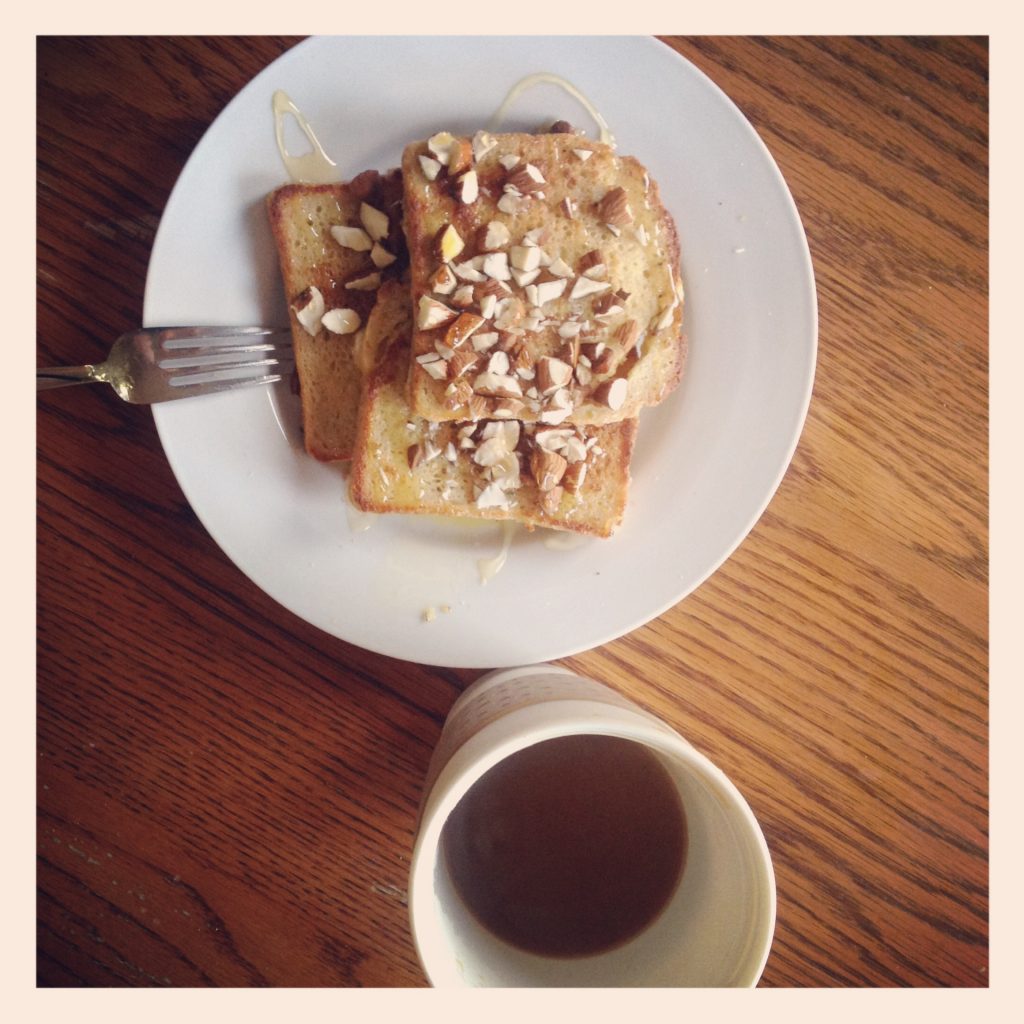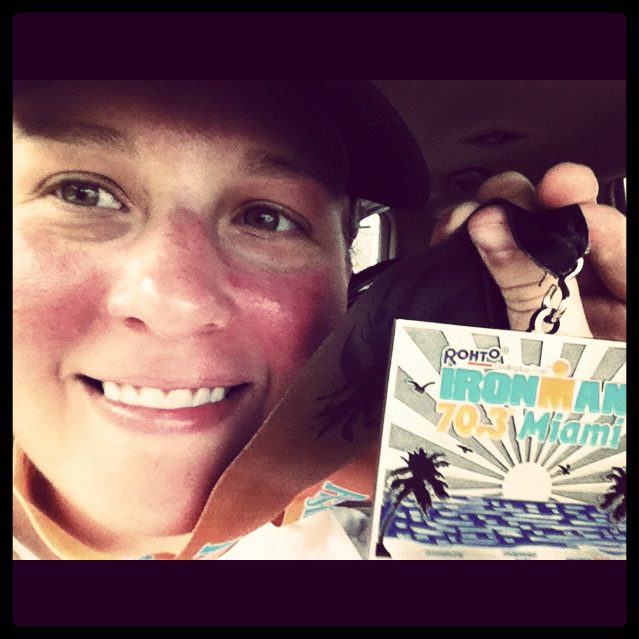I get a ton of email asking questions about how to fuel during training and on race day, so I thought I would do a quick post on what works for me, and maybe it will help you guys work through the process of your fueling.
Now, I know there are many theories on fueling… so if you don’t agree with me, please feel free to offer up what works for you as well. That way, we can get a wide range of conversations and ideas going to help everyone. [But don’t be ugly or combative about your fueling. Ain’t no need for all that.] Kumbayah!
BUT… first, I want to congratulate one of my dearest friends, Mountain Goat, for a sub-four hour MARATHON this weekend. Yes, marathon. Together now, let’s say: “We’re not worthy! We’re not worthy!”
Wowzers. That Goat is fast. I’m not great at math, but that pace is something like 8:20 per mile. Dude.
So I call her the Goat because she scales trails and mountains like a Goat. And she’s a vegan, so she doesn’t eat other animals or their by-products. And she’s nice too – you can read our 2011 Peachtree Road Race report here – anyway, yes… she is a nice Goat. And I just love the girl. If you’ve read my book, you know all about the Goat and how she and I tend to say “GO FOR IT” no matter what the endeavor. (She was also the star contributor on the Trail Running section—as this SBM does not do trails!) Anyway, the Goat was part of my big signing up for my first half Iron.
If you haven’t checked out the Goat’s blog, go here to read her report on the 2013 Publix Marathon. It’s a great read. And I like her summary of what she did different from last year’s race. You know how I love “things I’ve learned lists.” I am incorporating some of her ideas now, like adding tumeric to my supplement regimine.
WHY FUEL? The SCIENCE behind the Stuff.
Well, you are training and your body needs “stuff” to make it go. (Very scientific.) This stuff is called “glycogen” and it’s the source of “oooomph” that feeds your muscle and your brain. In fact, it’s the only fuel that allows the muscles to work. (You can use the terms glycogen and carbohydrates interchangeably for sports nutrition.) The kicker is that glycogen can only be stored in the muscles and liver for a limited amount of time. (BTW- most of this smartness is from Ilana Katz’s section in my book!). If you fail to replace this essential fuel during a workout, then you will endure fatigue, reduced endurance and may encounter the horrible “bonk” or —- the dreaded DNF (“Did Not Finish”).
By the way working out without fuel to “save calories” will actually do less good than you think. In fact, your “fat reserve tank” cannot be tapped unless there is glycogen present. Simply: fat may only be used as a fuel source in the presence of carbohydrates (glycogen)! The metabolism of carbohydrates provides the oxygen, or the flame so to speak, for your fat to burn.
During a workout or race, the goal should be to spare glycogen. In other words, you want to use glycogen as efficiently as possible. One of the most optimal ways to conserve glycogen is to consistently replace what is being oxidized. Now, you may not need to replace much during a sprint-distance race, but then again, you may need to depending on your weight and effort.
The human body oxidizes approximately one gram of carbohydrates per minute, thus equaling sixty grams per hour, so that should be your glycogen replacement goal. Thirty grams of replacement glycogen every thirty minutes is an optimal goal for carb replenishment.
Simply: 30 grams of glycogen every thirty minutes of training is optimal.
Conveniently, the well-marketed sports products have about twenty-five or thirty grams of carbohydrate in one serving. For example, one gel, packet of sport beans, chews or sports drink will automatically get you this specific glycogen replacement. A strategy to ingest at least of one of these approximately every thirty minutes during a workout or race is ideal. Remember, sports drinks that are low calories or calorie free (even sugar free, meaning carb free) will not accomplish this goal. (Thanks Ilana for the smart tips!)
And now for some Andy Potts… not that he has anything to do with fueling, per se… but who doesn’t like a little Andy?


HOW TO FUEL
Okay, back to it.
There are two types of “fuel” and they should be distinguished. There is electrolyte replenishment… and carbohydrate replenishment… and you should aim to do both during training and race day. Some sports drinks do both (think: Hammer Heed or Perpetuem; Accelerade); others are soley for electrolyte replacement (GU Brew, Hammer Endurolytes Fizz, or Nuun tablets). For me, I like to keep them separate. I have found this to be easier on my gut. Er, my stomach. Not my chunky gut. Check out lots of options of nutrition here at All3Sports.
In summary, you want to FUEL (think: carbs and calories) and HYDRATE (electrolyte replacement). You can fuel with “real” food, nutrition bars, or sports drinks (NOT zero calorie kind). You hydrate with liquids – water, electrolyte tablets in water, electrolyte pills (Salt Sticks), or sports drinks (zero calorie are okay for hydration only – remember they bring no carbs to the table!).
Fuel and hydrate. Fuel and hydrate. Fuel and hydrate.
TYPES OF FUEL
Real Food
Do not underestimate the power of a banana before a swim, some dried fruit or a peanut butter and honey sandwich on the bike. Really, if you can pack it and have room for it, I suggest you try it. Longer distance training sessions welcome food after you’ve been eating gels for hours. A good trick is to flatten out your PB&J with a rolling pin, then roll it up like a burrito and stick it in a baggie and store it in your jersey pockets. I have fit three sandwiches in my pockets with this trick. (Oh yeah!)


Bars, Wafers and the Like
There’s a wide assortment of fueling bars, wafers and waffles to eat on the road. These are probably best eaten before the swim or on the bike… tricky to RUN and eat these types. They pack some solid calorie replacement. Clif makes the popular Powerbar; there are the Stinger Waffles; the power-packed Bonk Breaker Bars; and the gluten-free new option, Picky Bars. You can even incorporate non-sports bars like Larabars or Kind Bars.


Gels, Bloks, and Beans
The stuff I call The Baby Food of Triathlon…. the easy to chew, easy to digest assortment of fuels. Gels such as GU and Hammer Gel pack the perfect glycogen replacement, and are easy to “eat” on the move. I am a big fan of Shot Bloks and GU Chomps on the bike and the run… but probably because I run so slow, it’s not a big deal for me to chew them. Sports Beans are just like jelly beans—can’t beat candy.


TYPES OF HYDRATION
Water with electrolyte tablets are my favorite hydration weapon. I like Nuun tablets, pure and simple. You can carry your hydration in a Fuel Belt (shorter workouts) or a Camelbak (longer workouts) during a run; you can use bottle racks, cages or hydration systems on your bike. For a two hour run on a hot day, I will fill my Camelbak with 70 ounces of water and 2-3 Nuun tablets. And yes, I will drink every ounce of it.
AND FOR EXAMPLE
To make some sense of the words that are coming out of my mouth, I thought I could show you what my nutrition looks like for two workouts and a race, to give you an idea of how I implement my nutrition for three scenarios:
1) A “short” workout;
2) A long workout; and
3) A half Iron race day
(Again, nutrition is very personlized… so you have to find out what suits you—-and figure it out before race day! Do what you plan to do on race day in your training. For me, I have many allergies, so I go with corn, soy and gluten-free where I can.)
Short Morning Workout of 1.5 hours
-Pre-workout coffee with banana and mandarin orange, or a piece of toast with almond butter
-During workout – bottle or two of water with a Nuun tablet for electrolyte replacement (I’m a heavy sweaty person!)
-After 45 minutes, I will take a GU gel or 3 Shot Bloks (they come in a pack of 6)


Long SBR Workout of 5 hours (1 hour swim, 3.5 bike, 30 minute run)
-Pre-workout coffee with gluten-free french toast, honey, banana and almonds – see recipe at bottom of this post– about 550 calories (yes, you will NEED that kind of calories!)
-1 hour swim (hydrate during swim with Nuun tablet in water)
-1 gel before the bike
-During the bike, for hydration I will have 2+ water bottles on the bike—-1 with water, 1 with Nuun –sip from each during the ride, and refill both at the halfway mark -and sometimes more depending on the heat (if very hot, I may take salt tablets)
-Every thirty minutes on the bike, I will take in some fuel, which consists of 1/2 or 1 gel, 3-4 shot bloks, OR 1/2 Larabar.
-Around the hour and a half mark, I will eat my sandwich
-Then back to gels or bar in thirty minute increments
-1 gel before the thirty-minute run.


Half Iron Race
– Pre-workout coffee with 2-3 slices of gluten-free bread and peanut butter
-Depending on the wave start, a banana or GU right before the swim
– Gel in transition after swim
-Proceed to hydrate and fuel on the bike just like on the long ride, above —but add a calorie-heavy bar or sandwich for sure during a race because you are likely expending more energy during a race than in training—sometimes I have been known to carry Peanut Butter M&Ms (shhhhh!) and take 3-4 salt tablets on the bike
-Gel in transition before the run
-Gel or bloks every 30 minutes during the half-marathon; hydrate with water and electrolytes
THINGS TO REMEMBER
Practice your nutrition plan during your training and stick to it on race day. If something upsets your stomach during training, don’t use it again – let it go and give the giant jug of whatever it is to your friend to try. It might work for him.
If you find that every 30 minutes is too soon to eat, then stretch it to 40-45 minutes. Find what you like (and what you don’t) and go with it (or dont’!).
Don’t use the goodies on the race course unless you’ve been using those goodies during training! If you don’t drink Gatorade during training, don’t use it in the race. A good tip is to find out ahead of time what the race will be offereing (most Ironman races use the Ironman brand drink)—then you can implement that into your training—-if it’s good in training, then you can use it in the race worry-free.


Finally, super-fast, seasoned triathletes may tell beginners—–“You don’t need to fuel in a sprint triathlon!” Well, I disagree. For anyone who is new to the sport or, say, over 165 pounds, I would say, Yes you do need fuel. And you should fuel. You may just need one gel on the bike or before the run—but don’t ignore fueling. Afterall, all of my sprint triathlons are over an hour… and to me, that means—-time to follow the rules and fuel somewhere!
Check out Ilana’s section in my book for more information, and special thanks to her for much of this great knowledge in my Swim Bike Brain…
In closing, I don’t have all the answers (of course!)—but I hope this helps you a little with things to think about and options and how you might could adapt to implement YOUR nutrition plan.
Now…. what do YOU do for YOUR fuel?







RT @SwimBikeMom: A post on fueling for long workouts! http://t.co/48IBoKFA9f #fitfluential #triathlon #swimbikemom
Gu Brew Blueberry Pomegranate flavor does have added electrolytes and has been my go to for ultra distance events. I am a big fan of trying out different things, I’ve done turkey sandwiches, potatoes, bars, etc, and find that everyone is different when it comes to what works for them. One of the biggest challenges I see people face is working too hard during a race, thinking they are riding in lower zones than they are, not eating enough, then bonking. It’s a tough thing to master, but once you get your nutrition down, don’t change it!
This post is very timely. I spent my whole masters swim this morning lamenting why I’ve gained weight this past week despite watching what I eat (mostly), and working out like a fiend. I struggle with trying to figure out how to fuel right for training and races and still lose weight. Even though I know that you need to fuel, I often skimp in order to keep down calories. But no more! I will try to focus on proper fueling and hopefully it will help, not hinder my weight loss. I am also going to eat peanut M & M’s during my next Half Ironman. Yum! Also, one thing that helps me is to not only practice my nutrition prior to a race, but actually map out my whole plan for race day in a spreadsheet. Not only does it take the guesswork out of it, but it also gives me something to think about during the race to help pass the time. “Only 30 more minutes until I get to eat M&M’s” for example!
I like to take fig newtons on my bike. Each newton has about 22 g carbs. So I take one about every 25-30 minutes or sooner, if I’m hungry. I don’t do a lot of gels. The texture grosses me out. GU Chomps Watermelon are yummy!
I don’t have any fuel tips to post…learning from what everyone else is saying because this is a HUGE question for me as I train for my first half ironman! Just had to say I got a giggle out of the random Andy Potts picture… = )
It took me weeks (maybe months) to figure out my nutrition during my half ironman bike training. Everything I tried made me feel sick. My “coach monster” suggested snickers miniatures – what? I must eat chocolate to feel better? BEST DAY EVER!! 4 minis has similar nutrition values as a honey stinger waffle. I ate one mini and 2 honey stinger chews every 15 minutes plus salt tablets and watered down perpetuem … and this is just the bike leg. Eating more often helped my stomach process the nutrition.
Thanks for the timely post. I am running my first 1/2 marathon in a couple of months and need to start planning my hydration and nutrition.
I used Infinit nutrition for my training and Ironman in September along with Bananas on the bike and water. It worked perfectly for me. My number one priority was to not have an upset stomach during or after the event and I did not. Google the site if you like they customize formulas for you. I had two one for the bike and one for the run. Again my nutrition plan wend off without a hitch. Certainly not a perfect race but was 100% pleased with the nutrition portion.
Carbs to the table! LOL!
Do you practice with peanut M&M’s? (hee hee)
This article is very informative and wonderfully easy to understand. I find it especially encouraging b/c it comes from someone who’s physically a lot like me. You give me great hope! 🙂
Great post (as usual)! My biggest problem is that just about everything makes me nauseous during training. About the only thing that hasn’t bothered me is GU gel and PR Bar. I haven’t tried a PB & honey during a ride, but I do have that before and I do ok. I like the M&M idea :).
Ha! I too enjoy fig newtons on the bike. Those and Hammer Perpetuem are my go-to’s for HIM training plus some Nuun tablets for flavor. Plus on race day I found that a mini snickers was an awesome treat 🙂
This is my big challenge for the summer, what to eat on a Half Ironman, can’t do gels and to much processed sugar. I will have to play around with real food options and a CLIF bar (I can tolerate one, no more then that). This will be interesting so thanks for the rolling pin trick, I will use that for sure.
Maybe I am missing something, but how do you fuel for your workout/race AND lose weight? I have been following the Metabolic Boost & Burn (or at least trying to) and typically do 1-2 hour workouts a day. I have never fueled during training nor during any of the sprint triathlons I’ve done. I want to do an international distance in the early fall, but also want to lose weight prior to then. So how do I practice my fueling AND lose weight in the process? It just seems like you are eating all of the calories that you are burning….help!
Years ago we raced Mt. Bikes and I can’t tell you how many times I felt sick or was sick afterwards. Now as I get into TRIs I’m learning why – I did not intake anywhere near enough carbs or electrolytes. I was trying to loose weight, I just did like to eat much while doing long workouts. I did drink lots and lots of plain water, which I now know made things worse. Fueling properly is so important to keep you going during the event, help you recover afterward and to help manage your weight.
I have always had good luck with ACTUAL baby food. Like the organic ones in the squeeze pouches from target. Esp sweet potato+anything. I have found I metabolize “real” food better, and the baby food really does the trick.
Love pretzels for race fuel – carbs and salt!
Thanks for all the great info!
Admiring the hard work you put into your blog and
detailed information you present. It’s great to come across a blog every once in a while that isn’t the same old rehashed information.
Great read! I’ve saved your site and I’m adding your
RSS feeds to my Google account.